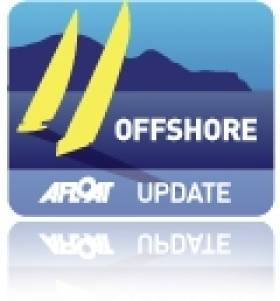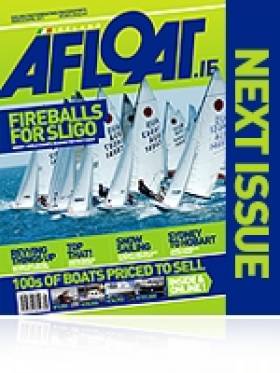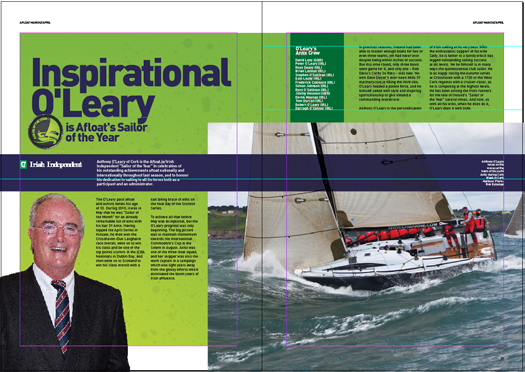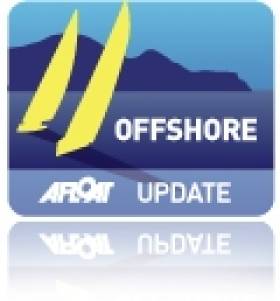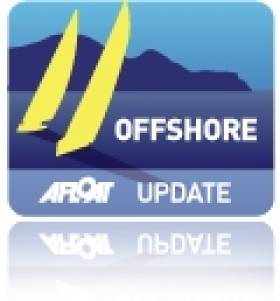Displaying items by tag: sydneyhobart
Yachts Prepare to Chase Sydney-Hobart Race Record
#OFFSHORE – Over its sixty-seven year history, the race record at the Rolex Sydney Hobart Yacht Race has only been broken ten times, an average of once every six and a half years. Given that the current fastest elapsed time of one day, eighteen hours, forty minutes and ten seconds was set in 2005, statistics suggest that the feat is due to be surpassed again.
That time was set by Bob Oatley's Wild Oats XI, a 100-ft Maxi yacht that has come to dominate the Rolex Sydney Hobart, claiming five of the last six line honours titles. She is the standout favourite for this year's title. The yacht, launched in 2005, has undergone regular and expensive enhancements throughout the past six years, yet has been unable to improve upon her record. Wild Oats XI finished within two hours of her record in 2008, the closest she has come, whilst the time set during her most recent victory saw her finish over 13 hours shy. Proof that in offshore racing, the elements dictate almost everything.
As is form in ocean sailing, the fastest time was broken frequently in the race's infant years. The inaugural winner was Captain John Illingworth's 35-ft Bermudan Cutter Rani, who finished, to her surprise, 17 hours ahead of second-placed Winston Churchill. The event evolved quickly, interest grew and entry numbers rose. There were four records set in the first six years alone. Claude Plowman's Morna achieved the feat twice. Her first triumph arrived in 1946 when the William Fife-designed 65-footer led the race from start to finish, finishing the 628-nautical mile challenge bereft of her main sail. Eerily similar to Wild Oats XI's famous finish in 2005 when the crew cruised through the last stretch of the Derwent River with only their headsail in tact. The crew reported arriving to a hospitable welcome in Hobart, having the sensation that they had been granted freedom of the city.
Two years later and with a crew of 16, Morna claimed her third consecutive line honours win, almost smashing her own record by a day, courtesy of champagne sailing conditions. She became the first boat in the race's four-year history to complete the race before the arrival of the New Year. Plowman received a knighthood just hours after crossing the finish line. Under the guise of Kurrewa IV, and new ownership, Morna was to take four subsequent line honours titles and one further race record.
After Margaret Rintoul set a benchmark of four days, two hours and twenty-nine minutes in 1951, the four-day barrier was broken in 1957 by the aforementioned Kurrewa IV, now owned by the Livingstone brothers. Ever since the end of the 1950s, surpassing the fastest time has become a much more irregular feat. In 1962, New Yorker Sumner A. 'Huey' Long steered one of two American record-breakers helming his lovingly-maintained 57-ft Ondine home in just under three days and four hours. This was the first of Long's three line honours triumphs at the event, the record attempt achieved following a tight battle with Astor in the Derwent River.
Ondine's record stood for an imperious nine years, when the 73-ft Helsal, owned by Dr Tony Fisher, the only purely Australian crewed and built race record holder, shaved barely two hours off the target. She marked a trend: at the top end of the fleet, the faster boats were getting bigger. A ferro-cement yacht, Helsal was nicknamed the Flying Footpath. Her victory is seen as something of a miracle given the problems encountered in rendering her race-ready and that her array of sails was relatively sparse and out-dated compared to her rivals.
The second United States success was achieved by Kialoa III in 1975. She shattered Helsal's 1973 time by just under eleven hours, the Sparkman & Stephens 79–footer taking advantage of ideal conditions and a fantastically consistent race, sailing at 15-20 knots throughout the second day. Overall, she averaged a speed of over 10 knots, not outstanding when compared to today's Maxis, but significant at the time. Californian Jim Kilroy had already helmed his Kialoa II to line honours four years earlier. When the crew arrived in Hobart at 03:36, the sky was so dark that the shoreline was barely visible. Kialoa III dominated Maxi racing during the mid-1970s – she was also the fastest on the water in the Transatlantic and Fastnet Races in 1975. Quite a year.
Where others had tried and failed, Hasso Plattner's 80-ft Reichel-Pugh Morning Glory succeeded, breaking Kialoa III's record by a meagre 29 minutes in 1996. It is almost startling that in an era of outstanding developments in the design and construction of yachts, and the onboard apparatus, that the record remained unsurpassed for so long. Indeed: almost a minute for every year that had passed. The 1996 race was renowned for a particularly harsh start with winds hitting 40 knots and steep sea state building up. Morning Glory enjoyed a stretch of cruising at 30 knots before the gusts abated near Tasman Island. But for the softening of conditions, she would have beaten the record by a much greater margin.
Following the tragic events of 1998, when six sailors lost their lives in harrowing conditions, 1999's race was characterised by the arrival of the forecast strong gusts and record-breaking conditions once more. The Volvo 60 Nokia sliced a massive 18 hours off the short-lived1996 figure, cruising down the South Wales Coast and into the Bass Strait, in winds of 30-40 knots. The race was a spinnaker extravaganza. The water-ballasted Nokia, led by Stefan Myralf and Michael Spies, one of an incredible seventeen yachts to break the record that year!
In 2005, the most recent race record went to Oatley's Wild Oats XI, another Reichel-Pugh design. Led by skipper Mark Richards, Wild Oats' commanding lead over the pack, set with an average speed of 15 knots, gave her an overall handicap win ensuring she was the first boat since the inaugural year to claim all three of the race's main prizes: line honours, race record and Tattersall's Cup. Wild Oats XI starts as favourite this year to beat her own record. Only one yacht has ever achieved that. Has the time come?
Afloat's March/April Issue Out Next Week!
Is there no end to the achievements of Irish boaters against seemingly impossible odds?
The winter may have been a time of hibernation for some of us but as the stories in Afloat's March/April issue will bear out Irish sailors have been battling the elements all winter long.
James Carroll competed in January's Sydney-Hobart offshore race and, much closer to home, Paul A. Kay journeyed through snow and ice in December from Dun Laoghaire to a new marina on Valentia Island.
As if to prove a point that we're down but not out, a winter of results on foreign waters includes a win in the Mirror World Championships in Australia and a top Olympic result in Florida, USA.
They are gutsy performances from youth teams that shows, if nothing else, the next generation of Irish sailors is really up for a fight. All this plus lots, lots more on news-stands next week!
Selected contents from Ireland's only boating magazine include:
News
Surveyors Issue Boat Launch Warning, Buoyant Dinghies Buck the Market, Ice Diving in Ireland, German U-Boat Rediscovered in Cork Harbour, an Historic Trophy for South Pacific Dream Cruise, MGM open in Cork, Hugh Mockler joins Crosshaven Boatyard plus lots, lots more.
News Focus
A new masterplan for Dun Laoghaire harbour is badly needed but it needs buy in from all those that use it
Going Offshore
The tenth Dun Laoghaire to Dingle offshore race was launched in style
Marine Conference
Combating the downturn was the focus of a unique marine gathering on both sides of the Irish sea.

Gear Review
New dinghy gear, a new Crosshaven boot from Dubarry, a new raincoat for girls and an upgrade for Musto's MPX.

This Island Nation
The decision to shut down the fog signals was based on a detailed risk assessment. Tom MacSweeney on the loss of fog horns
Sailor of the Year
Anthony O'Leary of Cork is the Afloat.ie/Irish Independent "Sailor of the Year" in celebration of his outstanding achievements afloat nationally and internationally.
Tall Ships
W M Nixon looks at the realities of national sail training in the 21st Century.
Tall Ship Conference
Ireland could yet have a tall ship to replace the Asgard II and the Lord Rank, if a new group formed to press for a replacement is successful
Racing update
Ulstermen's World Title, Topper worlds for Dun Laoghaire, Two Irish campaigns line up for Figaro Race, SB3 Sailors Cry Foul at Dun Laoghaire Parking Fees and an Irish entry in the Moth worlds in Australia, Irish Mini 6.50 Campaign in Prospect.

Youth Worlds preview
Results achieved abroad this Winter are the backbone for further Irish youth
success

Figaro Preview
Two fledgling Irish La Solitaire du Figaro campaigns edged closer to the start line last month
Volvo Dun Laoghaire Regatta
Volvo Dun Laoghaire regatta has taken in 22 entries six months ahead of the first race of the biggest regatta in Irish sailing.
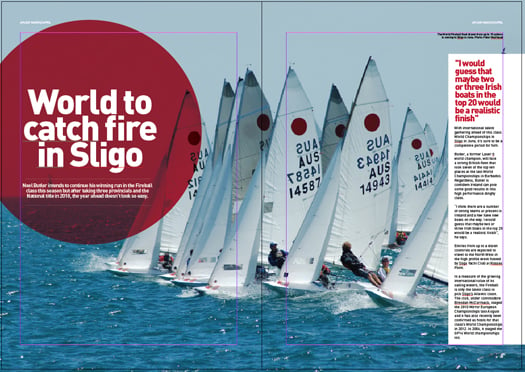
Fireball Worlds preview
Dun Laoghaire's Noel Butler intends to continue his winning run in the Fireball class this season but the year ahead doesn't look so easy as the World Championships come to Sligo
Sovereigns cup preview
Up to 30 Quarter tonners will be at the Sovereigns Cup this year including one from New Zealand.
Shiver to deliver
A journey through snow and ice from Dun Laoghaire to Valentia Island
Sydney-Hobart Race
Outside of the Volvo Ocean Race, the Sydney Hobart is one of the world's most challenging offshore races. James Carroll Raced it in January.
Inland
As the cuts begin to bite, it may be time to look at the British direction for our waterways, writes Brian J Goggin
Dubarry Nautical Crossword
Soundings
A Google aerial photo proves useful navigating for Baldoyle Estuary
- Anthony O'Leary
- Dun Laoghaire
- Tom MacSweeney
- Harbour
- MGM Boats
- Asgard II
- World Championships
- Dinghies
- Olympic
- Cork Harbour
- Valentia
- Mirror
- Dingle
- youth
- Lord Rank
- Island Nation
- Hugh Mockler
- Dubarry
- Tall ship
- brokerage
- sydneyhobart
- fog horn
- moth
- Mini 6.50
- Uboat
- Fireball worlds
- Sovereigns
- James Carroll
- Paul A. Kay
- Crosshaven Boatyard
- Baldoyle
- MPX
- W M Nixon
Beneteau Celebrates Success Down Under
Following the historic success of 2009 when two FIRSTs occupied the first two places in the overall IRC and ORC rankings, the 2010 race has seen another Beneteau double as two Firsts won their class in the 600-mile offshore fixture.
True to its reputation, the 2010 race took place in extreme conditions with winds reaching 45 knots and the suspense maintaine right to the end.
The well-named FIRST 45 Victoire won the race in IRC2. The FIRST 40 Paca was the winner in IRC3.
The Irish agent for Beneteau is BJ Marine.
Fleet Arrives in Hobart
Sean Langman and Anthony Bell's 100-foot super maxi Investec Loyal was the second yacht across the finish line of the Rolex Sydney Hobart Yacht Race, arriving last night just after midnight, three and a half hours behind the provisional line honours winner and race favourite Wild Oats XI.
Investec Loyal's sailing time to Hobart was two days, eleven hours and eleven minutes.
The yacht was on track to finish sooner; however as is often the case when arriving at the mouth of the Derwent River after dark, the breeze typically drops right off.
This was Langman's 20th Rolex Sydney Hobart race. Once across the line he congratulated the Wild Oats XI crew on being first to Hobart, only a few hours before. Asked whether he can challenge Bob Oatley's super maxi Wild Oats XI again and win, he responded, "definitely, there is more in this boat, more in the team."
"The first afternoon we were the faster boat, they were a slicker team. We'll change [that] though," Langman warned. "We sailed a seamanship race."
Later Wednesday morning, four more contenders crossed the finish line in Hobart: Lahana, Ichi Ban, Wild Thing and Rán.
The 30-meter fixed keel water ballasted Lahana, skippered by Peter Millard, completed the gruelling race in two days, fourteen hours, and nine minutes. Lahana arrived at the finish line at 3:09am 29 December. Like Investec Loyal crossing the finish line was frustrating as the winds on the Derwent River were all but gone.
The story was similar for Matt Allen's Jones 70 Ichi Ban. Allen and his crew sailed an inspiring race. The whole way they had been in the breakaway pack of four leading yachts, snapping at the sterns of their much bigger rivals and ahead of the remaining super maxi Wild Thing and the 72-foot mini-maxi Rán.
"Up to 2300 last night we had great running conditions. Our approach to Tasman Island was in a good northerly breeze," Allen said when he finally stepped onto Hobart's Constitution Dock after finishing at 0552 Wednesday morning.
"The breeze was still reasonable to Tasman Light, but then it got light at Cape Raoul. It picked up a bit later, but when we got to the Iron Pot it fell apart. There was no wind anywhere on the Derwent River. It didn't matter where you were on the River, there was nothing." Ichi Ban, veteran of five previous Rolex Sydney Hobarts, completed the race in a respectable two days, 16 hours and 52 minutes.
Grant Wharington's Wild Thing finished 23 minutes behind Ichi Ban at 0615 Wednesday morning while Zennstrom's Rán arrived seven minutes later at 0622.
Like Wild Oats XI, Rán also faces the same protest about the use of its radio from the event Race Committee. The International Jury will hear the protest at 1300 today at the Royal Yacht Club Tasmania.
This was Zennstrom's second Rolex Sydney Hobart Race. Commenting on the race conditions they encountered this year Zennstrom said, "I think I have now definitely seen what the race is all about. It was tough crossing Bass Strait; 35 knots of wind and big seas. The whole experience has been fantastic."
At 1030 Wednesday, saw the arrival of Alan Brierty's Reichel/Pugh Limit and less than three minutes later, Stephen Ainsworth's Loki. Both boats were locked in a dead heat for most of the race. According to Limit's owner Alan Brierty, "First Loki got in front, then we got in front. It was back and forth. We finally got in front and stayed in front at Tasman Light. Speaking of the neck-and-neck battle with Loki, Brierty said, "It was a race within the race. For us, it was the race."
Stephen Ainsworth reflected about coming in behind Limit, "We had done everything right. Limit just got away and we couldn't catch them. He then jokingly said, "After a while we thought, we hate this race."
Asked how this Rolex Sydney Hobart race compared with others, tactician and former America's Cup competitor Chris Dickson, tactician onboard Limit reflected, "This race wasn't any better or worst than any other Hobart. We still saw 45 knots of breeze, big breaking waves—it's just the Bass Strait."
Most of the race fleet is across the Bass Strait and is spread out along the eastern Tasmanian coast. Their race is far from over as tacticians will be working hard to navigate through a very large area of light and variable breeze along the coast, in the shadow of the island.
Race organisers announced the 17th retirement, Matthew Prentice's Archambault 40 Nautical Circle, which dropped out with engine problems and was headed to Eden.
Nine yachts have finished, with 61 yachts still racing. Still up for grabs is the Tattersall's Cup for the overall handicap win. Currently leading is Darryl Hodgkinson's Beneteau 45, Victoire, which would need to finish by 0736 tomorrow (Dec 30).
The entries for this the 66th edition of the Rolex Sydney Hobart Yacht Race included six international entries from the USA, UK, Italy, France, as well as two partly crewed Russian boats, and entries from seven of the eight Australian states and territories.
Race Tracker: Race enthusiasts can go to http://rolexsydneyhobart.com/yacht_tracker.asp for a real time tracker of yachts and their position.
Official race website: www.rolexsydneyhobart.com


























